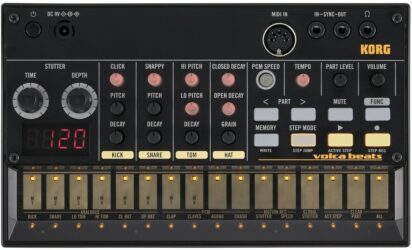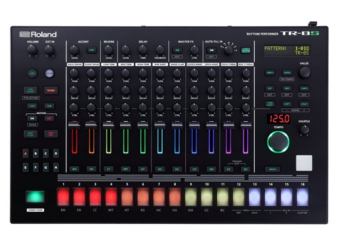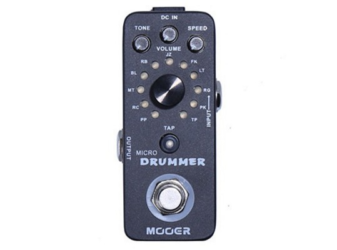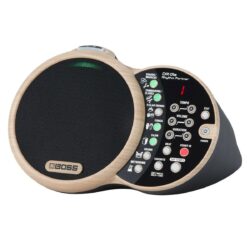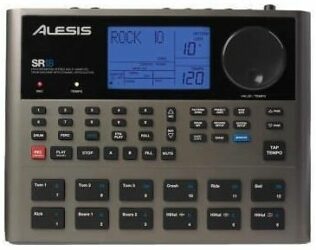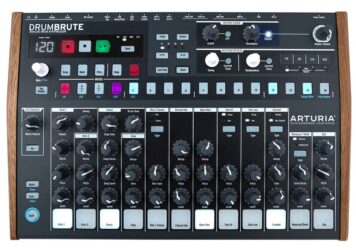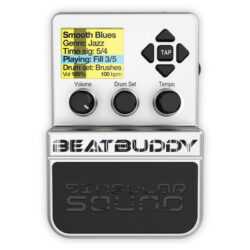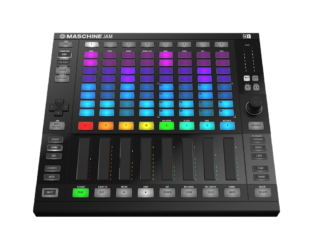If you are practicing an instrument or playing a live solo gig, you need to generate your own drum tracks. The problem is that drum sets take up a lot of space, and drummers are a scarce commodity. There are some backing tracks you could just play on YouTube, or you could record from a keyboard set to “drums.” Still, nothing matches the control and versatility of a dedicated drum machine.
We compiled a list of some absolutely fantastic drum machines for you to buy. This article will get you started with the basics. Then we have our reviews of the 10 best machines we think you should own. After that, we get into some of the details and explain some of the more nuanced things, and finally, we have a frequently asked question section to hopefully answer any concerns you have.
- Choosing a Drum Machine
- Top 10 Best Drum Machines 2025
- 1. Best Overall Drum Machine: Korg Volca Beats
- 2. Best Modern Drum Machine: Roland TR-8S
- 3. Best Budget Drum Machine: Mooer Audio Micro Drummer
- 4. Best Premium Drum Machine: Elektron Digitakt
- 5. Best Self-Contained Drum Machine: Boss DR-01S Rhythm Partner
- 6. Best Drum Machine for Live Gigs: Alesis SR18
- 7. The Classic Drum Machine: Roland TR-08
- 8. Most Powerful and Easy to Use Drum Machine: Arturia DrumBrute
- 9. Best Guitar Pedal Drum Machine: Singular Sound BeatBuddy
- 10. Awesome Tech Toy: Native Instruments Maschine Jam
- FAQ
- All About Drum Machines
- Have Fun Keeping Time
Choosing a Drum Machine
One of the hardest parts about buying a drum machine is that they can be staggering in their complexity. You’d think they’d be little more than fancy metronomes, but you will find that it’s easy to become overwhelmed by options when you go to pick one up. We tried to make it easy by breaking them down with ratings based on a few different categories so you can get set up quickly.
If you have about 20 minutes, though, watch this video put out by Reverb. He does an absolutely fantastic job hitting on most of the more complicated topics that we can only touch on, and he does it by demonstrating three of the machines we recommend.
The Metrics We Used for Analysis
The following is the breakdown of the way we categorized and described each drum machine. These kinds of facts at a glance will probably be your best tool in narrowing down what drum machine is going to work best for you.
Complexity
In this context, complexity is a measurement of how much a machine can do and how much customization there is.
- Simple: Simple machines can do little more than loop a preset rhythm with preset beats. They are more complicated than a metronome, but not much.
- Medium: Most traditional drum machines are relatively complex but still approachable. There are a lot of buttons, a lot of settings, and the ability to customize almost any sound. However, this complexity level stops short of having to manually input samples or control every single sound individually.
- High: Highly complex drum machines often cross the threshold from being an accompaniment to being an entire band. They require a lot of thought to utilize.
Usability
The usability is different from the complexity. A very complicated machine can be straightforward to use if all the dials and settings are easy to access and have an intuitive layout.
On the other hand, some machines are relatively simple, but all the settings are hidden behind layers of challenging to navigate menus.
- Easy: Easy to use machines often have a separate button or dial for every setting, are laid out in a straightforward manner, and can be learned in a few hours.
- Moderate: Machines that are a bit more difficult to use will have menus that have to be navigated or extra steps to get the sounds you want. Some require a computer to fully utilize, while others in this category will just have way too many settings to be considered easy to use.
- Difficult: Difficult to use machines have often made huge sacrifices in usability in order to be really good at something else. Sacrificing usability for the sake of portability is one of the more common reasons as buttons and dials take up a lot of space.
Type
Analog machines are more traditional. They usually sound warmer, and when you interact with the buttons and dials, you are directly affecting the sound.
Digital machines use a processor to emulate the sounds, and they are often more accurate. However, they feel different since you are basically changing software settings with the dials and buttons. There’s no right answer to which one is better.
Custom Samples
Compared to the other metrics, this category is really straightforward. Can you alter, record, and play your own samples for use in the loops? If you can, then the answer is yes. If you can’t, or if it’s very limited, then the answer is no.
Portability
If you are going to a bar to play a one-man guitar concert, you’ll need a machine that you can take with you. You do not want to be the musician that shows up to a gig dragging in a 200lb piece of equipment, wondering why no one will help you set up.
Make Sure It Does What You Want
Mainly, picking the right drum machine for your situation comes down to deciding what you want to use it for. If all you want is a simple machine to back you up while playing the piccolo, then you don’t need 24 customizable pads and an entire voicebank. On the other hand, if you are producing hip hop or EDM, you will probably want as much tone control as possible.
We have one last thing to note before we get into the review on this list: none of these machines are bad. They are what we believe are the ten best out of thousands, so even though we put one last on our list, it’ll still be a fantastic machine. Don’t think of this list as a definitive ranking. It’s a guide to see what’s out there and choose one that calls to you.
Top 10 Best Drum Machines 2025
1. Best Overall Drum Machine: Korg Volca Beats
Why we like it:
If you ask the average person to picture a drum machine in their mind, this is the thing they picture. It sounds like a drum machine, it lights up like a drum machine, and you can just look at it and know how it’s used.
Quick Specs:
- Complexity:Medium
- Usability:Easy
- Type:Analog
- Custom Samples:No
- Portability:High
- Listen Here:Youtube
What’s It Best For?
The Korg Volca series is the best starting point for anyone that wants to get into drum machines and custom beats. They are very tactile, versatile, and well laid out. The Volca Beats is analog, which means that it sounds exactly like a classic drum machine and is intuitive to use.
There are even some little features that make it extra easy to get into, like the built-in speaker and battery power. It’s easy to say that this is a drum machine that any musician will love.
Our Review
You’ll hear the number 808 a lot. It refers to the Roland TR-808, which is the father of all modern drum machines. It’s an analog beast that defined what drums sounded like in the 80s. It’s so prolific we recommend both the digital update and the reissue. The Volca Beats is like a distilled 808. It’s got a very similar analog sound and even kind of matches the aesthetic. The best part is, though, that the Korg is very affordable.
However, it doesn’t sound as good as the original. The onboard speaker isn’t great and even plugged in, it doesn’t have depth. It is meant to be simpler and more portable, so you have to make some sacrifices.
Also, the analog sound isn’t for everyone. If you like what the Beats offers but prefer crisp modern sounds, check out the Korg Volca Drum instead. It’s nearly identical, just digital instead of analog.
If you ask us “what drum machine you should buy?” and we don’t have any other information, though, we’d say it’s this one.
Pros
- Portable
- Very easy to use
- Has a very classic analog sound
- Has very classic looks to go with the classic sound
Cons
- Other machines will give you more control
- The onboard speaker is a little weak
2. Best Modern Drum Machine: Roland TR-8S
Why we like it:
It’s a do-everything-you-could-want monster of a machine from a company that practically invented the modern drum machine. The TR-8S is a worthy successor to the holy 808 lineages.
Quick Specs:
- Complexity:High
- Usability:Moderate
- Type:Hybrid
- Custom Samples:Yes
- Portability:Medium
- Listen Here:Youtube
What’s It Best For?
The TR-8S bridges the gap between synth and drum machine; it’s an all-in-one beat creation station. Chances are if you have been to see producers doing live sets, you’ve seen one in action.
It’s a little on the pricey side, but if you are an electronic artist looking to take the step away from simple software controllers and upgrade your workstation, take a look.
Our Review
One of the coolest things about the TR-8S is that Roland kept it easy to use. It’s not anywhere near as simple as a Korg Volca, but all the pads, sliders, and knobs are laid out cleanly. Anyone can sit down at a TR-8S and understand what’s going on. That’s something that really separates it from something that requires a lot more computer control.
At the same time, it’s very modern. First, as is required in modern clubs, everything lights up, and the lights are programmable. Second, the S in 8S stands for sampling. You can load your own samples onto it, something that users of the original 808 could only dream of.
The downside is that since it straddles the line between MPC and drum machine, it suffers from the drawbacks of both. As a sequencer, it’s large and a bit complicated. It doesn’t have nearly enough buttons as a midi controller, and it makes a very expensive drum machine. It is all of those things, though, and it’s a Roland. You can’t go wrong with this thing.
Pros
- Roland’s quality is unmatched
- Looks fantastic
- You can load custom samples
- It’s laid out really well
Cons
- It’s a bit expensive
- It’s a bit of a jack of all trades, master of none.
3. Best Budget Drum Machine: Mooer Audio Micro Drummer
Why we like it:
This tiny drum machine is perfect for practicing guitar. It’s probably not something you would bring for a live show, but it’s very inexpensive and really beats practicing to a click.
Quick Specs:
- Complexity:Simple
- Usability:Easy
- Type:Digital
- Custom Samples:No
- Portability:Very High
- Listen Here:Youtube
What’s It Best For?
The Micro Drummer is for practicing guitar, and it’s incredible for that purpose. It’s a pedal that fits on any pedalboard and uses standard pedal power, and it has the standard ¼” input and output.
The best thing about it is that it could not be easier to use. You get a selection knob for selecting from various beats, and you get a knob that controls the speed of the beat. That’s it.
Our Review
You will notice that there are two distinct categories of drum machines on our list. The first category is programmable machines. These are your classic knob and button devices that you have to manipulate. Then there’s the second category: the kind preloaded with rhythms and patterns, and you can’t really change anything but the tempo.
The Micro Drummer is that second category taken to its extreme. You get an on-off button, and you should be thankful that they included one. You can get the Volca Beats if you want to make your own beats; it’s got 40 times the number of buttons and sounds better.
If you value simplicity and just want an easy-to-use practice or songwriting tool, the Micro Drummer is perfect. There isn’t anything simpler or less expensive on our list.
Pros
- Incredibly simple to use
- Inexpensive
- It’s a guitar pedal and integrates easily with a board
Cons
- There’s very little customization
- There’s even less variety
Why we like it:
The Elektron is an expensive piece of equipment, but it has unparalleled versatility.
Quick Specs:
- Complexity:Very High
- Usability:Difficult
- Type:Digital
- Custom Samples:Yes
- Portability:Medium
- Listen Here:Youtube
What’s It Best For?
At its core, this machine is a sequencer that has a gig of storage and can handle 64MB samples loaded directly from USB. It’s perfect for changing the shape and duration of samples live and is basically an entire computer that you control with knobs instead of a keyboard.
If that doesn’t mean much to you or sounds too complicated, this machine probably isn’t for you. The Alesis SR18 is a very competent digital drum machine that functions in a very similar manner, and it’s less than half the cost. If you are a beginner, get that one.
Our Review
Allow us to be honest with you for a moment. This machine does more than we can list, and probably more than we can understand. It has so many controls and features that two people could pick it up, use it in a live set, and do nothing similar to the other.
That means that the truth is that if you are looking for a drum machine that can do what this machine can do, you probably already know it’s the one you will buy.
For everyone else, just be aware that this is the hardest tool to use on our list. Many settings require crazy button combos, and it can be very difficult to just make simple patterns. Just watch this guy try to explain a lot of it. It’s a 40-minute video going over the basics, and you’ll still have questions.
Pros
- Massive amount of functionality
- Compact
- Has a ton of storage for samples
Cons
- It’s a very complicated, hard to use machine
- It’s pretty expensive
5. Best Self-Contained Drum Machine: Boss DR-01S Rhythm Partner
Why we like it:
It’s really simple to use, and it has its own speaker so you can use it to jam at the park.
Quick Specs:
- Complexity:Simple
- Usability:Easy
- Type:Digital
- Custom Samples:No
- Portability:Very High
- Listen Here:Youtube
What’s It Best For?
We have a few machines on our list that are very simple drum machines that just require you to press a few buttons, and they’ll play a beat. The Micro Drummer is the simplest, but you really need an electric guitar to get the most out of it. The Boss Rhythm Partner is for everyone else.
It’s got a very competent speaker, so you don’t need an amp to go with it. It’s battery-powered, and it’s still ridiculously easy to use. Anyone playing a live acoustic gig or busking on the street will love it.
Our Review
The Rhythm Partner is about as close as you can get to having a drum-playing robot follow you around. It’s not a sequencer or a controller; you won’t get to load your own sounds or change the prerecorded sections or anything. But it does keep perfect time and can make tons of different sounds, which is all you really need if what you want to do is play guitar with some drums.
What really separates the Rhythm Partner from the Micro Drummer or Beat Buddy is the lack of a need for an external amp. Both the guitar pedals are really designed and meant to fit on a pedalboard, and they need to be amped.
The Rhythm Partner is bigger and has more buttons, so it’s easier to use. It can also be played with any instrument; you can add a drum track to your kalimba jazz if you want; no electronics are required.
Pros
- Doesn’t need an amplifier
- Very easy to use
- Sounds great
Cons
- You don’t get much control over the sound
- You are limited to the preset beats
6. Best Drum Machine for Live Gigs: Alesis SR18
Why we like it:
It’s excellent for live performances because of how portable it is and how great it sounds. The fact that it’s ultra-versatile is just icing on the cake.
Quick Specs:
- Complexity: High
- Usability:Moderate
- Type:Digital
- Custom Samples:No
- Portability:Medium
- Listen Here:Youtube
What’s It Best For?
The SR18 has a ton of preset patterns, and all of them are highly customizable. What that gives you is the ability to plug it in anywhere and get a competent drum track with very little fussing.
Throw it into the mix at the bar where you are about to play your own special breed of piano blues, and you’ll never have to worry about the drummer stealing your beer.
Our Review
The Alesis SR18 is a hybrid between a much more complicated machine like the Elektron Digitakt and a much simpler machine like the Rhythm Partner. If you just want it to be a straightforward, press a button and get drums type of machine, it’ll do it, and do it well. If you want to record your own patterns and tweak the sounds, it can do that too.
You do lose a bit of usability because of that, though. To cram the pad functions into the compact design, a lot of the buttons serve multiple uses. That leads to a layer of complexity that you won’t find on machines with a ton of separate dials for every function; if you want to add a filter to a sample, you have to select it, enter the menu, and then turn the multi-function value knob.
Also, and this is subjective, but it looks very boring. It kind of has a 90s calculator vibe to it. It’s fine for turning on and hiding under your stool as you jam, but you’d never have it sitting next to a sequencer during a live electronic set or anything.
The upside is that you cannot get more functionality for the money. This little machine can do just about anything you could possibly want from a drum machine. Just as long as you’re willing to memorize the commands to get it there.
Pros
- Highly versatile
- Has a ton of pre-installed sounds and patterns
- Can be very simple to use
Cons
- Can also be very complicated to use
- It looks very plain
7. The Classic Drum Machine: Roland TR-08
Why we like it:
The Roland 808 is “the machine” that you needed in the 80s. This modernization retains the look and feel of the legendary 808.
Quick Specs:
- Complexity:Medium-High
- Usability:Moderate
- Type:Hybrid
- Custom Samples:No
- Portability:Low
- Listen Here:Youtube
What’s It Best For?
The TR-08 is for people that want a classic machine. It’s for people who don’t want to record samples, don’t want to mess with a computer, and just want a simple drum machine with a great, old-school tactile look and feel. If you have used an 808 and want that same feeling, this modern machine can give it to you.
Our Review
It’s hard not to love the old school cool that Roland brings with the TR-08. It sounds like a classic drum machine, it looks like one, and after you leave it in a smoke lounge for a few weeks, it’ll even smell like one.
It can do a lot more than an original 808 can, though. You can record entire rhythm tracks and loop them into the mix, and save sequences. The technology to store that much information just didn’t exist in the 80s when the 808 was released, and they are really nice features to have.
Unfortunately, that does mean that the TR-08 is more complicated and a bit harder to use than the original. That can lead to some awkwardness because people who are not used to using older equipment won’t find the layout intuitive, and people who are used to using original machines will have to learn new things.
Pros
- Old-school look and feel
- Legendary Roland quality
- Has the unmistakable 80s sound
Cons
- It’s a little harder to use than the original
- The layout might turn modern tech users off
8. Most Powerful and Easy to Use Drum Machine: Arturia DrumBrute
Why we like it:
The DrumBrute looks like a piece of equipment that you would find in a high-end recording studio, but it’s designed around being easy to use.
Quick Specs:
- ComplexityHigh
- UsabilityEasy
- Type:Analog
- Custom Samples:No
- Portability:Very Low
- Listen Here:Youtube
What’s It Best For?
Do you want a drum machine that will make you feel like you are in a space shuttle? Arturia wants you to have that.
As we said in our intro, having a ton of knobs and switches doesn’t make a machine harder to use; it makes it easier. Instead of hunting for an hour for the right menu item to select a snare and add heavy decay, you just press the snare button and turn the dial. It’s labeled in friendly white letters and everything.
Our Review
The Drumbrute is a modern drum machine that’s been broken down and spread out. Everything is right out in the open; it’s a very hands-on device. You can spend hours playing with the different knobs as it loops; it’s a totally different workflow than a digital device you program before sequencing.
The thing you have to be prepared for is even a very simple drum machine like the Volca Beats is still really complicated. When you spread out all the functions, you get a ton of buttons and knobs. That means two things. One, it’s big. You won’t be taking it to a coffee shop to work out a new song.
Second, you will be spending a ton of time learning through experimentation. If you enjoy that, great. If you don’t, grab the Volca Beats instead.
As a final note, the Drumbrute has one unique feature that we need to point out. Every voice has its own output channel. Most people probably don’t care, but there are definitely some hardcore synth lovers that just smiled at the idea of having 12 sequenced outputs to play with.
Pros
- It’s very hands-on
- It has individual outputs
- You can craft a huge variety of sounds and beats
Cons
- It’s big
- It’ll take you a while to craft the sound you want
9. Best Guitar Pedal Drum Machine: Singular Sound BeatBuddy
Why we like it:
Need correction
Quick Specs:
- Complexity:Low
- Usability:Difficult
- Type:Digital
- Custom Samples:No
- Portability:Very High
- Listen Here:Youtube
What’s It Best For?
The Beat Buddy is a guitar pedal like the Micro Drummer. That’s about where the similarities end because the BeatBuddy is an incredibly complex machine for looking so simple.
It’s fully programmable, it has hundreds of sounds, and it sounds really good. It also has some totally unique features, like an instant-fill button that adds a drum fill when you tap the pedal.
Features like that take this pedal from a practice aid and turn it into a full-on performance and recording tool.
Our Review
The Beat Buddy is a really great drum machine with one major downside: hundreds of features are all controlled with a few buttons. Watch the sample we have linked, and you’ll see two things. The first is that it has a ton of really amazing sounds and rhythms. The second is that it takes him forever to find them because he has to scroll through approximately a hundred options to get to the one he wants.
What saves it is that it’s a really amazing tool for guitarists. If you are a guitarist, that’s the reason you would buy the relatively expensive beat buddy over something like the Alesis SR18. The Alesis is just as competent, and it’s easier to use, but it doesn’t include preloaded famous songs to play along with.
Pros
- Has thousands of backing tracks for you to play over, included from famous songs
- Can be customized infinitely using software
- Fits nicely on a pedalboard or any amp loop
Cons
- It can take forever to get the beat you want
- There are much better options if you don’t play guitar
10. Awesome Tech Toy: Native Instruments Maschine Jam
Why we like it:
The Maschine isn’t technically a drum machine; it’s a midi controller. However, if you are looking to sample and build your own crazy drum loops, it makes an amazing drum machine.
Quick Specs:
- Complexity:High
- Usability:Difficult
- Type:Digital
- Custom Samples:Required
- Portability:Medium
- Listen Here:Youtube
What’s It Best For?
Some people find drum machines to limiting. They want total and complete control over the samples and want to switch up the order at any time. Maybe add chromatic notes into the mix and build the entire drum loop from the ground up. Those people are often called producers, and they love colorful pads like this.
Our Review
If you aren’t familiar with devices like this, they can look really intimidating. There are more than 50 buttons, and most of them are not labeled. It’s got funny sliders, a joystick, and it lights up like a Christmas tree. Worse yet, if you plug it into a speaker alone, you won’t get any sound.
It’s easier to think of the Maschine like the controls for an arcade game than a stand-alone instrument. You assign sounds to the buttons using a computer, and then you can play that assigned sound every time you press the button. It’s more than that, though, because it’s also a sequencer. That’s why it can double as a powerful drum machine.
See, all drum machines are sequencers. They play sounds or patterns in a sequence. It’s just that most drum machines are fairly rigid. You get 16 or so steps that can each be assigned a limited number of sounds.
Even the highly customizable Roland TR-8S has a strict structure to it. You can’t do things like press and hold a note while isolating a specific tone; you have to add things into the sequence.
The Maschine has no such limitations, which is both freeing and terrifying. You are on your own when it comes to making beats. Thankfully, they include the software with the device. At least you don’t have to go down that rabbit hole.
Pros
- The LED pads look fantastic
- It’s very versatile
- It comes with software
Cons
- Needs to be used with a computer
- Has a very steep learning curve
FAQ
As we’ve said, drum machines can be overwhelming. Thankfully, we’ve answered the most common questions about them here.
That depends on your situation, but unless you have a drummer at your disposal at all times, the answer is probably. It’s a lot more fun than just playing with a click, and they offer a much better tactile feel than clicking a mouse.
A sequencer is a device that plays one sound after another in a set sequence. A drum machine is a sequencer with a bunch of sounds pre-installed and is set up to create and play rhythms.
Software like GarageBand often includes a digital drum machine, as do most other production tools. If you want something more tactile and traditional, even very cheap electric keyboards have drum kits. This Casio can play and record drum loops, and it barely costs more than a hearty lunch.
Yes. There are quite a few, in fact. Drumbit is very easy to use in browser, and the popular free recording software Audacity has an entire section dedicated to free Audacity friendly programs.
A digital or hybrid drum machine will often have a wider range of sound samples and can sound more realistic. However, many people prefer the sound of an analog machine, so it’s not fair to say that digital is better.
Analog and digital are just two separate ways to solve the same problem. The better one is simply the one you like better.
All About Drum Machines
As you are probably now very aware, a drum machine can be a huge number of different things that range from simple, on/off digital beatboxes to full-on workstations. It can be really overwhelming. We write about this stuff for a living and still stumble into things that blow our minds; there’s no shame feeling like you might have gone in too deep.
We want to give you some great information that will act as a starting point towards learning a lot more. Let’s start with something that you might be wondering after going through the list; why would you even want a device like that?
The Advantages of a Drum Machine
There are a lot of ways to lay down a beat track. You could play the drums or emulate drums on an old electric keyboard. You could sample hundreds of things and use a tape deck to mix them into a loop, or you could use one of the hundreds of computer programs to generate drum noises. Here are the reasons that you would choose a drum machine over all those options.
- They can be much easier to use. The automatic looping and preloaded sounds mean you don’t need to know how to keep time or play the drums.
- They can do a lot more than just play a drum track. Many are entire electronic orchestras in a box.
- Lots of people prefer having a hands-on device for making music. Sometimes it’s hard to feel creative when all you are doing is clicking a mouse.
- They take up a lot less space than a drum set.
Glossary of Terms
We throw a lot of terminology at you throughout this article, so we wanted to take a second and define the common terms. You’ll see these terms here and anywhere you look when learning about drum machines.
- Channel: Each channel is a separate circuit and has a dedicated output on an analog device. The simplest channels are the left and right channels of a stereo signal.
- DAW: Digital Audio Workstation. It’s a program that you use to make music, including producing, editing, and recording your audio.
- Midi: MIDI, or Musical Instrument Digital Interface, is the standard technology for connecting instruments to computers.
- Midi Controller: A Midi Controller is a device that is specifically for use with computer programs to make music with. Often, they look like little pianos, but there is no standard shape or layout.
- MPC: A Music Production Center is an all-in-one DAW.
- Samples: A sample is a prerecorded sound. It can be an entire melody or a single note.
- Sequencer: An Audio Sequencer is a programmable device that can play patterns and melodies. In short, they take inputs and samples and arrange them into a sequence to be played.
- Synth: A synthesizer is an instrument that can generate audio. Often by shaping or distorting a generated tone or sample. They are a staple of EDM, 80s Pop, and Video Game soundtracks.
- Tracks: A track is a layer of a recording. It’s helpful to think of it like a band where each instrument creates its own track. When the drummer plays, they are creating the drum track.
- Voice: A voice is a specific sound. On a drum machine, “snare” would be a voice that can be played on a channel to create a track.
The More Complicated Things
In the buying guide above, we touched on many different things, and in the glossary, we defined a lot of the basics. Here we are going to touch on some of the more complicated things you need to know about to make the best decision on a machine possible.
Each one is highly dependent on what you want, so it’s better to know what you want from a machine and match these to your desire than try to choose a device based on these criteria.
Inputs and Outputs
There are many different inputs and outputs that you can find on a drum machine. Guitar inputs for pedals, ¼” and ⅛” outputs for monitors and headphones, and USB inputs for computer control are the ones that are the most common.
Other inputs and outputs include MIDI for connecting multiple devices and XLR for powered line outs. There are more, so if you have something specific you want, make sure to double-check.
Connectivity
In addition to the inputs and outputs, different machines will support working in different environments. While a simple guitar pedal probably can’t connect well to an analog synth, a large analog drum machine will connect easily.
MIDI and USB are the ones to look out for in our modern era, but if you have classic machines or specialized devices, you may want to make sure any drum machine you buy can integrate into your workstation.
Pad Sensitivity and Feel
This category is easily the most subjective thing that isn’t sound-based. If you don’t like the feel of small knobs or hate how hard you have to press the pads for a good response, you won’t like certain machines.
The best way to get an idea of how it will feel is to watch other people use the machines. We include sample videos for all of them for reasons like that.
Memory
There are two functions of memory. The first is easy; the more memory a device has, the more songs and samples you can store on it. That’s the ROM for all you computer literates.
The second is a bit more complicated; it’s the amount of information a sample can contain, usually expressed in seconds. A controller that can handle a 20-second sample will have an issue if you try to load a 30-second one onto it.
Voices
A voice is a sound, and the more voices a drum machine has, the more sounds you get to play with. Most machines will have a simple drum kit: snare, toms, bass, cymbal, and kick. They can have anything, though, and many include the ability to add custom sounds. You’ll have to decide how many is enough.
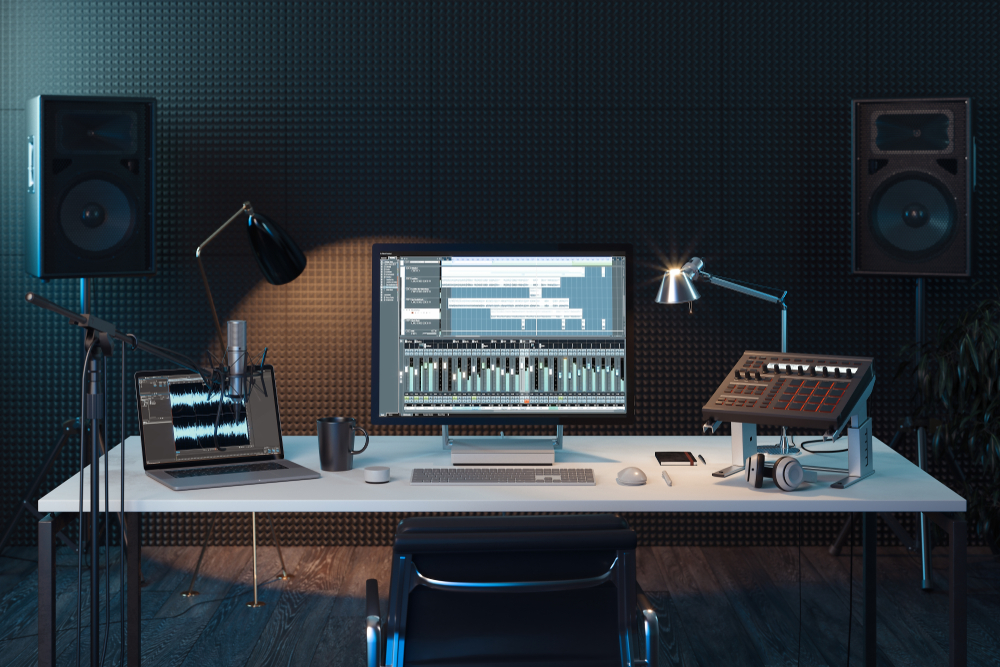
Have Fun Keeping Time
A solid drum track is essential to all music. It’s the foundation for dance, and it’s a necessity for keeping time. With a drum machine, there’s no excuse to not have the perfect beat.

